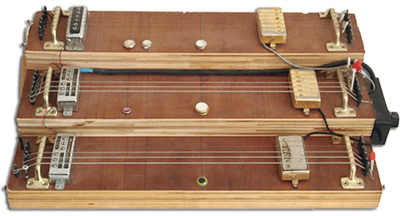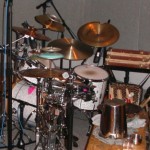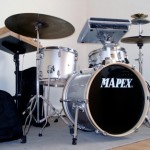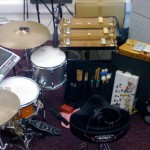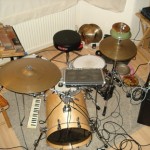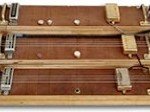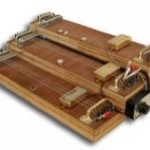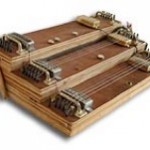The original concept was to build an instrument that would allow for percussive drones (many years prior I had made a recording in which I used 3 guitars, tuned to open tunings, to create a wall of drone/polyrythm), and the occasional prepared guitar clanging. All available from the drumset. It turned out to be much much more than I had ever anticipated.
It’s made of furniture grade plywood, salvaged guitar pickups, brass door handles, and auto harp tuning pins.
There are three levels, each with its own function/tuning.
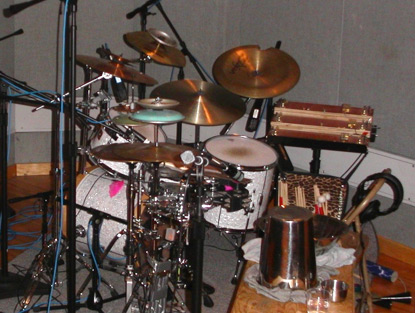
Early Specto setup from the ‘Your Vision of Yourself’, “Failure, Arc of Beauty” recording session.
This was also the peak of my ‘large’ drumset setup, with two toms, several cymbals, two hi-hat stands covered with percussion bits and bobs.
Tuning
The top level is tuned to C#5, D5, D 1/4# 5, D#5, D 3/4# 5, and E5.It functions as a high-end drone, and full melody level. By ‘fretting’ with a drum stick at an angle, or ‘bowing/rubbing’ with a drum stick I can produce anything from slightly chorused unison tones, to a cluster of microtonal filth. Because of the layout of the instrument, it is the only level that can be bowed easily/fully. I don’t bow very much as I can’t seem to not break/lose bows, but bowing produces exceptional results. I also use this level for any electronics I run through the pickups (usually a micro-cassette player or toy keyboard).
The middle level is tuned to C4, D4, B4, C5, E5, and F#5.
This level serves as the main ‘complex melody’ level. The interval layout lends itself well to lap-steel-esque playing, with available octaves, 6ths, 2nds, 3rds, 4ths, and 5ths! I have the equivalent of fret markers on the instrument, so I am able to visualize where the 5th, 7th, and 12th frets would be. This makes playing melodies on this level relatively easy. Using an E-bow between this level and the top level gives some nice microtonal shimmer to whatever else is happening.
The bottom level is tuned to B2, B3, B4, B4, B4, and B4.
Here I produce most of the rhythmic drones, as well as bass lines and things of the sort. Because of it’s proximity to me when in playing position on the drums, and it’s unison nature, this level gets most of the attention when I’m using the Specto in conjunction with the drumset. With all the strings tuned to B using regular gauge strings, this level is also the slackest level, tension wise. This gives it a nice warble/twang when hitting/fretting/plucking it hard. Chinese massage balls rolled or vibrated (held in place, and tapped quickly) on this level produce a really nice vibrato effect.

The SPD-S Sampler is now a staple of the kit, and this marks the beginning of the ‘small sized’ kit with 12” snare and floor tom, not to mention only one cymbal, the ride.
Playing Techniques
I began playing the Specto very simply and crudely. Banging on it with sticks. It sounds amazing doing this, as this was it’s original design. But after mounting it on a music stand, and having it setup closer to my body, I was able to do a bit more than that (it originally sat on a chair next to me).The second major turning point, which eventually allowed the Specto to be used extensively in my band at the time, “Failure, Arc of Beauty”, was the addition of a volume pedal placed next to the hi-hat pedal on the left side.
As it is a stringed instrument, nearly all techniques used stringed instruments are applicable here, so I shall just detail the ones that I gravitate towards.
STICKS : Using sticks (full drum sticks, or chop-sticks etc..) I’m able to do percussive taps/rhythms/drones. I can also ‘fret’ (by pressing the stick onto the strings, sidewise) on any of the layers to produce set pitches. The ‘fretting’ is most useful on the top and bottom level as they serve well for unison playing. The middle level produced chords if I do this. Not exactly what I want all the time.
Because of the tuning of the instrument, this means the bottom layer can play ‘bass lines’, or low rumbles, by tapping the stick once its on the strings, and the top layer can produce high melodies, or because of the tuning, tight microtonal clusters.
When using the specto in a ‘prepared’ fashion, using two smaller sticks (chopsticks), make for a perfect mini prepared piano type setup. There aren’t too many strings, so you don’t have as many choices as with a real prepared piano, but it is still very useful.
Because of the tuning setup of the second level, I often use a stick in my left hand as a slide/capo while finger picking with my right hand. I can get relatively lap-steel type playing this way, but with a warmer/wood tone because of the stick. Hammer-ons are also quite effective.
FINGERS : My fingers are most often used to finger pick while my left hand frets/slides/capos either either a stick, or a lap-steel slide, but playing the Specto like hand percussion works very well. The bottom level gives you great control since it is very slack, by adjusting your pressure you can get a very dry/muted sound, or a bright springy one. On the bottom level, I have one tuning peg over an inch from the bridge on the left side. Since the tuning is so slack, by applying a little pressure on that spot, I can produce very eastern sounding glisses/melodies. I don’t use this too much as it sounds a bit cliche, but it sometimes gets used.
ELECTRONICS : The most common electronic usage of the Specto is the E-bow. I can sometimes, depending on the angle, balance the E-bow on a string, and do other things, leaving a nice drone ringing away. Also, because of the microtonal tuning used in the top level, I can E-bow some nice clouds of tones this way.
A micro-cassette recorder gets the next biggest amount of attention on the Specto. I have a tape recorder that I filled with various random recordings years ago, which when placed near any of the pickups (usually the top level, for ease) gets picked up, and amplified. If I put it close enough, I get that electronic hum of the motor turning away.
The most recent addition has been a toy megaphone, which has been part of my ‘knick knacks’ next to my drumset for quite a while. I often use the megaphone to produce feedback by cupping the microphone side. During the recording session with PA Tremblay I found that by doing so, while aiming the speaker side of the megaphone at one of the Specto’s pickups, I was able to coax a much larger range of feedback whoops and wails.
MISCELLANEOUS : I use various other techniques/instruments when playing the Specto, but the rest don’t warrant their own section.
For ‘prepared’ Specto I generally use alligator clips of various sizes/types, paperclips, and thin sticks of various sizes/thickness/materials.
I have several chinese zen balls that I use to roll on the strings, or strike the Specto at various points (the brass bridges sound particularly nice when struck with the balls).
Standard drumset brushes sound great on the Specto, when used right above the pickups as the thin strands get ‘stuck’ to the strings by the magnets in the pickups. It produces a nice ‘thumping’ sound, in addition to the scraping sound the brushes produce on their own.

This is the setup circa 2009. The Specto portion has remained the same, although for recording setups it’s usually a bit further from the ride than normal, to make room for the tom mic.
The Maple Pork-Pie snare is in full swing, and this marks the debut of the Ciat-Lonbarde Sidrassi Tom as part of the drumset. You can’t tell from this picture, but the floor tom is wired up to have piezos inside of it.
Practical Setup and Usage
Since the Specto uses guitar pickups, and is run into a guitar amp, it is very mid heavy, and takes up a very guitar-centric frequency range. At first I didn’t like this, since I was hoping for a more full range usage, but later it grew on me (much like using the SPS-S sampler through a guitar amp).The limited frequency range compliments the drumset well as it doesn’t get in the way of cymbals(highs) and tom/kick(lows). You can read more about the specifics of my approach in an academic paper (not as boring as it sounds!) I wrote.
One of the earliest problems I encountered when having the Specto set up next to the kit was sympathetic vibrations. It would just quietly hum away on it’s own. The remedy for this was the addition of a volume pedal. It was used at first only to quiet the Specto when not in use, but I later found that I could use it to either fade in the Specto while doing something else, or for having the Specto jump in on a hit/stab. By playing the Specto loudly, while muted, I can use my left foot, and the rest of my limbs to hit parts of the kit loudly, in a way I wouldn’t be able to if I had to hit the Specto at the same time.
As far as usage, the Specto has found a home in my more experimental groups (Failure and TSC especially), as well as solo improvisations. It doesn’t really get used in my more “normal” groups although it’s made small appearances in sample form as it would be difficult to lug the Specto to a gig only to use it for a tiny section of one song.
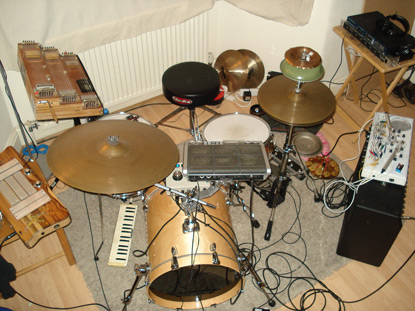 This is the current (2011) setup. The bass drum is now a 16″ converted floor tom. You can see most of my staple instruments in this picture too. The Electric Whisks, the Sidrassi-Tom, the Party Bus, etc…
This is the current (2011) setup. The bass drum is now a 16″ converted floor tom. You can see most of my staple instruments in this picture too. The Electric Whisks, the Sidrassi-Tom, the Party Bus, etc…Here are some videos of the Specto in action.
